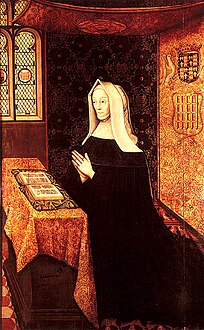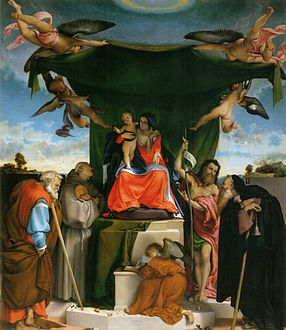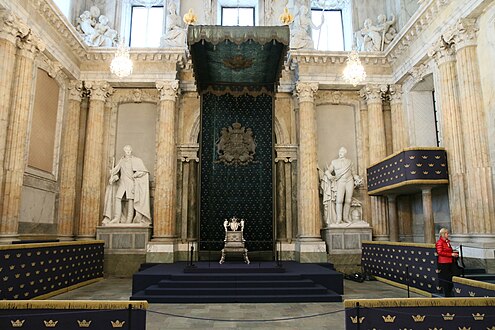Baldachin

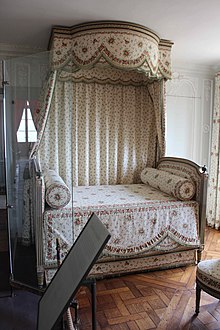


Abaldachin,orbaldaquin(fromItalian:baldacchino), is acanopy of statetypically placed over analtarorthrone.It had its beginnings as a cloth canopy,[a]but in other cases it is a sturdy, permanentarchitecturalfeature, particularly overhigh altarsincathedrals,where such a structure is more correctly called aciboriumwhen it is sufficiently architectural in form. Baldachins are often supported on columns, especially when they are disconnected from an enclosing wall.[1]Acloth of honouris a simpler cloth hanging vertically behind the throne, usually continuing to form a canopy. It can also be used for similar canopies in interior design, for example above beds, and for processional canopies used in formal state ceremonies such as coronations, held up by four or more men with poles attached to the corners of the cloth.
"Baldachin"was originally a luxurious type of cloth fromBaghdad,from which name the word is ultimately derived, appearing in English as "baudekin"and other spellings.Matthew Parisrecords thatHenry III of Englandwore a robe "de preciosissimo baldekino"at a ceremony atWestminster Abbeyin 1247.[2]The word for the cloth became the word for the ceremonial canopies made from the cloth.
Canopies of state
[edit]In the Middle Ages, a hieraticcanopy of state(or "estate" ), cloth of honour, orcloth of statewas hung above the seat of a personage of sufficient standing, as a symbol of authority. The seat under such a canopy of state would normally be raised on adais.The cloth above a seat generally continued vertically down to the ground behind the seat. Emperors and kings, reigning dukes and bishops were accorded this honour. In a 15th-century manuscript illumination the sovereign Grand Master of theKnights Hospitallerin Rhodes sits in state to receive a presentation copy of the author's book. His seat is raised on a carpet-covered dais and backed with a richly embroidereddosser(French,dos). Under his feet is a cushion, such as protected the feet of the King of France when he presided at alit de justice.The King of France was also covered by a mobile canopy during his coronation, held up on poles by severalpeersof France. TheVirgin Maryin particular is very often shown sitting under a cloth of honour in medieval and Renaissance paintings where she is shown enthroned with saints.
The cloth was often simply a luxurious textile, often imported and with rich patterns, as inbrocades,but might have heraldic elements. French kings are often shown with blue cloths patterned with the goldfleur-de-lys.Margaret Beaufort,mother ofHenry VIIin her portrait by an anonymous artist, c. 1500 prays under a canopy of estate; one can see thedosseragainst the gilded leather wall-covering and the tester above her head (theTudor roseat its centre) supported on cords from the ceiling. The coats-of-armsembroideredor woven into thetapestryare of England (parted as usual with France) and the portcullis badge of the Beauforts.
Sometimes, as in thepresentation miniatureJean Wauquelin presenting his 'Chroniques de Hainaut' to Philip the GoodbyRogier van der Weyden,the cloth continues over the seat, and then to the floor. In the summer of 1520, a meeting was staged betweenFrancis I of FranceandHenry VIII of England,where the ostentatious display of wealth and power earned the meeting-place the name ofThe Field of Cloth of Gold.The canopy of estate may still be seen in most formalthrone rooms.
State bed
[edit]Ceremonial
[edit]The state bed, intended for receiving important visitors and producing heirs before a select public, but not intended for sleeping in,[3]evolved during the second half of the seventeenth century, developing the medieval tradition of receiving visitors in the bedroom, which had become the last and most private room of the standard suite of rooms in a Baroque apartment.Louis XIVdeveloped the rituals of receptions in his state bedchamber, thepetit leverto which only a handful of his court élite might expect to be invited. The other monarchs of Europe soon imitated his practice; even his staunchest enemy,William III of England,had his "grooms of the bedchamber", a signal honour.
The state bed, alit à la duchesse—its canopy supported without visible posts—was delivered for the use of QueenMarie LeszczyńskaatVersailles,as the centrepiece of a new decor realised for the Queen in 1730–35.[b]Its tester is quickly recognisable as a baldachin, serving its time-honoured function; the bedding might easily be replaced by a gilded throne. The queens of France spent a great deal of time in theirchambre,where they received the ladies of the court at the morningleverand granted private audiences. By the time Marie Antoinette escaped the mob from this bedroom, such state beds, with the elaborateetiquettethey embodied, were already falling out of use. A state bed with a domed tester designed in 1775–76 byRobert Adamfor Lady Child atOsterley Park[c]and another domed state bed, delivered byThomas Chippendalefor Sir Edwin Lascelles atHarewood House,Yorkshire, in 1773[4]are two of the last English state beds intended for a main floor State Bedroom in a non-royal residence.
For sleep
[edit]In Britain, monarchs slept in a state bed in thePalace of Westminsterthe night before their coronation. This tradition was started byWilliam the Conquerorin 1066 and continued until 1821, whenGeorge IVwas the last monarch to sleep in the bed. The original state bed was damaged in a fire and replaced in 1859. The new bed remained in theSpeaker's Houseuntil the 1940s, when it was moved out as too opulent to be there during the difficult times of theSecond World War.It was probably sold during a government modernisation, somehow appeared in an auction in Northamptonshire, and was bought for a family for £100 in the 1960s. They used it for thirty years, recognising that it was important but not knowing where it came from until an interiors expert at theVictoria and Albert Museumpublished an appeal to try to find it. The bed was bought back from the family and returned to Speaker's House after restoration and with new hangings. It can be viewed during tours of the Speaker's House.[5]
St. Peter's Basilica
[edit]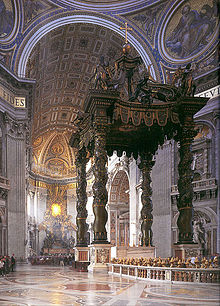
Pope Urban VIIIcommissionedGian Lorenzo Berninito design and construct a large structure that would be placed over the main altar, believed to be above the tomb ofSaint Peter,in the newSt. Peter's Basilica.[6]The canopy imitated cloth in bronze, as did many subsequent imitations. This famous and spectacular feature is generally called the "Baldacchino", though strictly it is aciborium.
Bernini's design for the Baldacchino incorporated giantsolomonic columnsinspired by columns that ringed the altar of the Old St. Peter's.[7]These columns were originally donated byConstantine,and a false tradition asserts they are the columns from theTemple of Jerusalem.The lowest parts of the four columns of Bernini's Baldachin have a helical groove, and the middle and upper sections of the columns are covered in olive and bay branches, which are populated with a myriad of bees and small putti. Pope Urban VIII's family coat of arms, those of theBarberinifamily, with their signature bees, are at the base of every column.[8]
All of these combine to create a feeling of upward movement.[9]
Processional canopy
[edit]
A baldachin may also be used in formal processions, includingroyal entries,coronationor funeral processions, tosignify the elite statusof the individual it covers. The origins of such an emblematic use in Europe lay in the courts of theNeo-Assyrianstate, adopted inAthensperhaps as early as the late seventh century BC, but relegated to the use of women by the late fifth century (compareparasol).[10]
Such canopies might be made of anything from muslin to heavy brocade, or even constructed of less flexible materials, and are supported by poles, whether affixed to a carriage, or carried by people walking on each side. An Egyptian pharaoh, for example, was escorted both in life and in death by such a canopy of estate.
Francisco Franco,the ruler of Spain from 1939 to 1975, frequently walked under a baldachin after formally proclaiming Spain a monarchy—a privilege he appropriated as de facto regent for life.
InSpanish Holy Week processionsthe sculptures of Virgin Mary, shown as Queen of Sorrow, use to go on their floats under canopies with embroideries Madr with gold or silver yarn
Surname Baldacchino
[edit]The surname Baldacchino comes from the artisans who used to make the Baldachin. The surname is found mainly in the islands of Malta and Sicily, particularly in Agrigento and Naro.
Gallery
[edit]-
The Grand Master of the Knights Hospitaller at Rhodes under a canopy of estate, on a dais: there is a cushion under his feet.
-
Margaret Beaufort,Queen Mother, at prayer, by an anonymous artist, about 1500
-
A cloth of honour held over the Virgin by angels, in an altarpiece byLorenzo Lotto
-
AtVersailles,theChambre de la Reinefeatures the centrally-placed state bed delivered for QueenMaria Leszczinska.
-
A baldachin inEmpire styleabove adaybed
-
Balachin in blue decorated withfleurs-de-lysin the former royal residence ofChâteau de Blois
-
Our Lady of Hope under canopy.Holy Week in Salamanca,Spain
-
Our Lady of La Naval de Maniladuring the enthronement rites atSanto Domingo Church
See also
[edit]Notes
[edit]- ^Baldacis a medieval Latin form forBaghdad,whence fine silks reached Europe.
- ^The hangings were rewoven for Marie Antoinette. The present hangings, made at Lyon by the same firm that delivered the originals, replicate the hangings as they were in 1787.
- ^Of this grandiose bedHorace Walpoleasked in a private letter "what wouldVitruviusthink of adomedecorated by a milliner? "
References
[edit]- ^"Baldachin | architecture".Encyclopedia Britannica.Retrieved2020-08-12.
- ^Richard Ettinghausen et al.,The Art and Architecture of Islam: 650-1250,1987, Yale University Press (Yale/Penguin History of Art)
- ^Peter K. Thornton,Authentic Decor: the Domestic Interior 1620–1920,(London, 1985) andSeventeenth-Century Interior Decoration in England, France and Holland,(New Haven & London, 1981).
- ^Annabel Westman and Aasha Tyrrell, "The Restoration of the Harewood State Bed" (on-lineArchived2006-03-17 at theWayback Machine)
- ^Whannel, Kate (30 January 2023)."The family that bought the King's bed for £100".BBC News.
- ^"Vatican unveils plans for restoring Bernini's canopy in St. Peter's Basilica".Associated Press News.11 January 2024.
- ^"Vatican unveils plans for restoring Bernini's canopy in St. Peter's Basilica".Associated Press News.11 January 2024.
- ^"St. Peter's - Papal Altar & Baldacchino".
- ^"St. Peter's Basilica in the Vatican | History, description, useful information".27 November 2016.
- ^M. C. Miller, "The Parasol: An Oriental Status-Symbol in Late Archaic and Classical Athens,"The Journal of Hellenic Studies,112 (1992) 91-105.
Further reading
[edit]- "baldachin (architecture)".Encyclopœdia Britannica.
- Peterson, John Bertram (1907)..In Herbermann, Charles (ed.).Catholic Encyclopedia.Vol. 2. New York: Robert Appleton Company.


